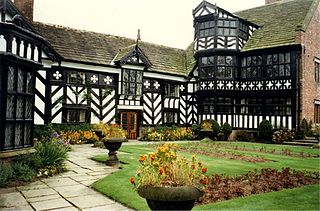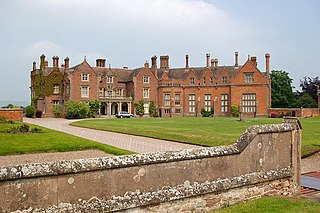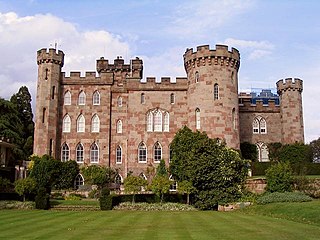
Gawsworth Old Hall is a Grade I listed country house in the village of Gawsworth, Cheshire, England. It is a timber-framed house in the Cheshire black-and-white style. The present house was built between 1480 and 1600, replacing an earlier Norman house. It was probably built as a courtyard house enclosing a quadrangle, but much of it has been demolished, leaving the house with a U-shaped plan. The present hall was owned originally by the Fitton family, and later by the Gerards, and then the Stanhopes. Since the 1930s it has been in the possession of the Richards family. Raymond Richards collected a number of items from other historic buildings and incorporated them into the hall.

Loton Park is a country house near Alberbury, Shrewsbury in Shropshire, on the upper reaches of the River Severn. It is a Grade II* listed building. It has been the seat of the Leighton family since 1391.

Acton is a small village and civil parish lying immediately west of the town of Nantwich in the unitary authority of Cheshire East and the ceremonial county of Cheshire, England. The civil parish covers 762 acres (3.08 km2) and also includes the small settlement of Dorfold and part of Burford, with an estimated population of 340 in 2006. It is administered jointly with the adjacent civil parishes of Henhull and Edleston. Historically, Acton refers to a township and also to an ancient parish in the Nantwich Hundred covering a wide area to the west of Nantwich. The area is agricultural, with dairy farming the main industry. Around a third of the area falls within the Dorfold Estate. Historically, agriculture was the major employer, but it has now been overtaken by the service industries, with many residents commuting significant distances outside the parish to work.

Burford is a village and civil parish in Shropshire, England.

Adlington Hall is a country house near Adlington, Cheshire. The oldest part of the existing building, the Great Hall, was constructed between 1480 and 1505; the east wing was added in 1581. The Legh family has lived in the hall and in previous buildings on the same site since the early 14th century. After the house was occupied by Parliamentary forces during the Civil War, changes were made to the north wing, including encasing the Great Hall in brick, inserting windows, and installing an organ in the Great Hall. In the 18th century the house was inherited by Charles Legh who organised a series of major changes. These included building a new west wing, which incorporated a ballroom, and a south wing with a large portico. It is possible that Charles Legh himself was the architect for these additions. He also played a large part in planning and designing the gardens, woodland and parkland, which included a number of buildings of various types, including a bridge known as the Chinese Bridge that carried a summerhouse.

Cholmondeley Castle is a country house in the civil parish of Cholmondeley, Cheshire, England. Together with its adjacent formal gardens, it is surrounded by parkland. The site of the house has been a seat of the Cholmondeley family since the 12th century. The present house replaced a timber-framed hall nearby. It was built at the start of the 19th century for George Cholmondeley, 1st Marquess of Cholmondeley, who designed most of it himself in the form of a crenellated castle. After the death of the Marquess, the house was extended to designs by Robert Smirke to produce the building in its present form. The house is designated by English Heritage as a Grade II* listed building.

Wilderhope Manor is a 16th-century manor house in the care of the National Trust. It is located on Wenlock Edge 7 miles (11 km) south west of Much Wenlock in Shropshire, England. The manor is a Grade I listed building and since 1937 has been used as a youth hostel.

Dorfold Hall is a Grade I listed Jacobean mansion in Acton, Cheshire, England, considered by Nikolaus Pevsner to be one of the two finest Jacobean houses in the county. The present owners are the Roundells.

Broxton Old Hall is in Old Coach Road 0.5 miles (1 km) west of the village of Brown Knowl, in the civil parish of Broxton, Cheshire, England. It is recorded in the National Heritage List for England as a designated Grade II listed building.

Kinlet Hall is an 18th-century, 33,609 square feet (3,122.4 m2) English country house at Kinlet, Shropshire, England, now occupied by an independent day and residential school. It is a Grade I listed building and its design was inspired by Villa Pisani, Montagnana.
Hampton Hall is a country house in Worthen, Shropshire.

St Mary's Church, Burford, is located near to Burford House in Shropshire, England, about 0.7 miles (1 km) to the west of Tenbury Wells. It is an active Anglican parish church in the deanery of Ludlow, the archdeaconry of Ludlow, and the diocese of Hereford. Its benefice is united with those of eleven other parishes to form the Tenbury Team Ministry. The church is recorded in the National Heritage List for England as a designated Grade I listed building.

Frank Hearn Shayler or Frank Shayler (1867–1954) was a Shrewsbury-based architect who worked in an Arts and Crafts style. He was in partnership with Thomas Ridge, and they also had offices in Oswestry and Welshpool.

Arkwright House is in Stoneygate, Preston, Lancashire, England. The house was built in 1728, and was later expanded and restored. It is notable as the place in which Richard Arkwright and colleagues worked in 1768 to develop the water frame, a machine for spinning yarn. The house is an example of Georgian architecture, and is recorded in the National Heritage List for England as a designated Grade II* listed building.
Burford is a civil parish in Shropshire, England. It contains 13 listed buildings that are recorded in the National Heritage List for England. Of these, one is listed at Grade I, the highest of the three grades, two are at Grade II*, the middle grade, and the others are at Grade II, the lowest grade. The parish contains the village of Burford and the surrounding countryside. Some of the listed buildings are grouped around Burford House and its neighbouring St Mary's Church to the southwest of the village. Otherwise, in and around the village, the listed buildings include a bridge over the River Teme, a hotel, a hospital, a cottage, a former toll house, and two mileposts.
Church Preen is a civil parish in Shropshire, England. It contains five listed buildings that are recorded in the National Heritage List for England. Of these, one is listed at Grade II*, the middle of the three grades, and the others are at Grade II, the lowest grade. The parish contains the village of Church Preen and the surrounding countryside. The oldest listed building is the church, which dates back to the 12th century. The other listed buildings date from the 1870s, around the time when Richard Norman Shaw designed Preen Manor, which was built on the site of a previous monastery. The manor has since been demolished and replaced by another house, which is not listed, but some structures associated with the manor have survived and are listed.
Hadley and Leegomery is a civil parish in the district of Telford and Wrekin, Shropshire, England. It contains ten listed buildings that are recorded in the National Heritage List for England. Of these, one is at Grade II*, the middle of the three grades, and the others are at Grade II, the lowest grade. Hadley and Leegomery are areas in the town of Telford. The most important building in the parish was Apley Castle, but this has been largely demolished and redeveloped, and what remains of it is listed at Grade II*. Other structures associated with the building are listed, and the other listed buildings in the parish include two former mills, an 18th-century house, two locks and a bridge associated with the now disused Shrewsbury Canal, a public house, and a war memorial.

Oakly Park, Bromfield, Shropshire, England is a country house dating from the 18th century. In the early 19th century, the house was restored and extended by Charles Robert Cockerell, Surveyor to the Bank of England for his friend Robert Henry Clive. The private home of the Earls of Plymouth, Oakly Park is a Grade II* listed building.

Davenport House is an historic country house in the English village of Worfield, Shropshire. Located to the southwest of the village centre, it was built around 1727, and is now a Grade I listed building. Its grounds are listed at Grade II status.

55–56 High Street is an historic building in Much Wenlock, Shropshire, England. The property dates to the early 15th century, and is now a Grade II listed building.

















